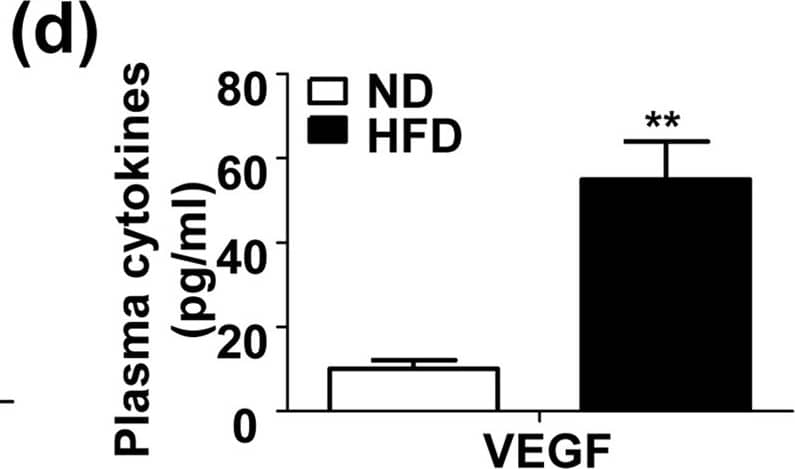Mouse VEGF Quantikine ELISA Kit Best Seller
R&D Systems, part of Bio-Techne | Catalog # MMV00

Key Product Details
Assay Length
Sample Type & Volume Required Per Well
Sensitivity
Assay Range
Product Summary for Mouse VEGF Quantikine ELISA Kit
Product Specifications
Assay Type
Format
Measurement
Detection Method
Conjugate
Reactivity
Specificity
Cross-reactivity
Interference
Precision
Intra-Assay Precision (Precision within an assay) Three samples of known concentration were tested on one plate to assess intra-assay precision.
Inter-Assay Precision (Precision between assays) Three samples of known concentration were tested in separate assays to assess inter-assay precision.
Cell Culture Supernates, EDTA Plasma, Serum, Tissue Homogenates
| Intra-Assay Precision | Inter-Assay Precision | |||||
|---|---|---|---|---|---|---|
| Sample | 1 | 2 | 3 | 1 | 2 | 3 |
| n | 20 | 20 | 20 | 20 | 20 | 20 |
| Mean (pg/mL) | 37.7 | 144 | 277 | 38.3 | 138 | 291 |
| Standard Deviation | 3.1 | 6.2 | 12.9 | 3.2 | 7.8 | 18.5 |
| CV% | 8.2 | 4.3 | 4.7 | 8.4 | 5.7 | 6.4 |
Recovery for Mouse VEGF Quantikine ELISA Kit
The recovery of mouse VEGF spiked to three levels throughout the range of the assay in various matrices was evaluated.
| Sample Type | Average % Recovery | Range % |
|---|---|---|
| Cell Culture Supernates (n=9) | 103 | 95-114 |
| EDTA Plasma (n=5) | 91 | 82-103 |
| Heparin Plasma (n=4) | 89 | 87-94 |
| Serum (n=9) | 101 | 83-115 |
| Tissue Homogenates (n=3) | 91 | 76-107 |
Linearity
To assess the linearity of the assay, samples containing and/or spiked with various concentrations of mouse VEGF in each matrix were diluted with Calibrator Diluent and then assayed.

Scientific Data Images for Mouse VEGF Quantikine ELISA Kit
Mouse VEGF ELISA Standard Curve
Mouse VEGF Quantikine ELISA Kit
Increased production of proinflammatory cytokines and VEGF in the plasma and chondrocytes in high fat diet (HFD)-feeding mice.(a~d) levels of plasma IL-6 (a), TNF-alpha (b), IL-1 beta (c) and VEGF (d) in the C57BL/6 male mice fed with a normal diet (ND) or HFD for 8 weeks. (n = 5, **P < 0.01). (e~h) Relative mRNA expression of IL-6 (e), TNF-alpha (f), IL-1 beta (g) and VEGF (h) in the chondrocytes isolated from the 8-week ND or HFD-feeding mice. (n = 5, **P < 0.01). Image collected and cropped by CiteAb from the following open publication (https://pubmed.ncbi.nlm.nih.gov/26271607), licensed under a CC-BY license. Not internally tested by R&D Systems.Preparation and Storage
Shipping
Stability & Storage
Background: VEGF
Long Name
Alternate Names
Entrez Gene IDs
Gene Symbol
Additional VEGF Products
Product Documents for Mouse VEGF Quantikine ELISA Kit
Product Specific Notices for Mouse VEGF Quantikine ELISA Kit
For research use only
⚠ WARNING: This product can expose you to chemicals including N,N-Dimethylforamide, which is known to the State of California to cause cancer. For more information, go to www.P65Warnings.ca.gov.

